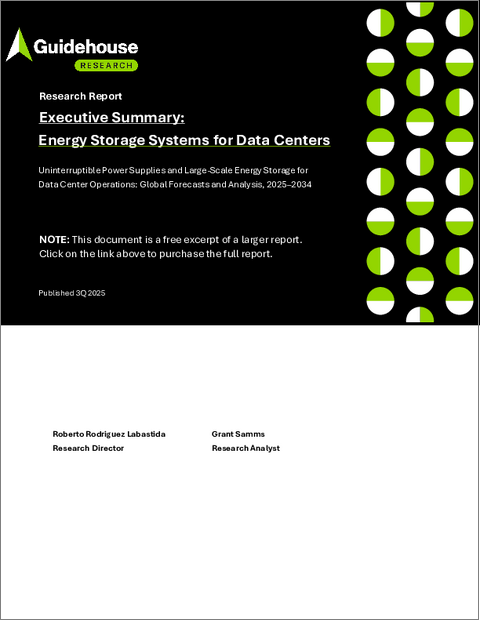|
|
市場調査レポート
商品コード
1778166
データセンター向けエネルギー貯蔵システム市場Energy Storage Systems for Data Centers - Uninterruptible Power Supplies and Large-Scale Energy Storage for Data Center Operations: Global Forecasts and Analysis, 2025-2034 |
||||||
|
|||||||
| データセンター向けエネルギー貯蔵システム市場 |
|
出版日: 2025年07月28日
発行: Guidehouse Research
ページ情報: 英文 38 Pages
納期: 即納可能
|
全表示
- 概要
- 図表
- 目次
データセンターにおけるエネルギー貯蔵システム(ESS)市場は、電力回復力と持続可能性という2つの要請によって形成され、急速に進化しています。無停電電源装置(UPS)は依然として基盤技術であり、系統障害時の稼働時間を確保するために普遍的に導入されています。同時に、脱炭素化目標をサポートし、化石燃料発電機への依存を減らし、エネルギー市場への参入を可能にする、長時間エネルギー貯蔵(LDES)を含む、より長時間の大規模ESSへの関心も高まっています。しかし、高コスト、規制の不確実性、統合の課題により、これらのシステムの導入は依然として限定的です。
この調査レポートは、UPSシステムを中心に、データセンターにおけるESSの現在と予測市場を分析しています。ITシステムの耐障害性、排出削減、エネルギーコスト管理の必要性などの主な促進要因や、政策の不安定性、安全性への懸念、送電網の制約などの障壁について調査しています。また、電力会社との提携や電力購入契約など、特にハイパースケーラーを中心に新しい形のESS導入を可能にする新たなビジネスモデルについても検証しています。
データセンターにおける大規模ESSの初期段階であることから、当レポートではUPSシステムについてのみ定量的な予測を行っています。これらの予測は、世界の地域別、ストレージ技術別、データセンターの階層別に区分され、2034年までの容量と収益の予測が含まれています。また、データセンター事業者、ユーティリティ企業、ストレージプロバイダーが、急速に変化するエネルギー情勢をどのように乗り切っているのか、最近のM&A活動やプロジェクト発表にも注目しています。
目次
第1章 エグゼクティブサマリー
第2章 市場の問題
- イントロダクション
- ストレージのタイプとテクノロジー
- UPS
- 大規模ESS
- 促進要因
- 施設のレジリエンス
- 持続可能性目標
- コスト削減
- データセンターの負荷増加
- 抑制要因
- コストと投資
- 政策と規制の不確実性
- 安全上の懸念
- スケーラビリティとグリッド制約
- 価格
第3章 産業バリューチェーン
- 競合情勢
- M&A活動
- ビジネスモデルの進化
第4章 市場予測
- 調査手法
- 世界市場
- 地域市場
- 北米
- 欧州
- アジア太平洋
- ラテンアメリカ
- 中東・アフリカ
第5章 結論・提言
- 3つの大きなポイント
- 推奨事項
- データセンター開発者および運営者
- エネルギー貯蔵プロバイダー
- ユーティリティ
- 政策立案者と規制当局
第6章 頭字語と略語一覧
第7章 目次
第8章 図表
第9章 調査範囲、情報源、調査手法、注釈
List of Tables
- Table 2-1. Energy Storage Technology Comparison
- Table 3-1. Data Center UPS Capacity Market Share by Region: 2025 and 2034
- Table 3-2. Recent M&A and Investment Activity, Data Center Market
- Table 3-3. Recent Large-Scale ESS Projects, Data Center Market
List of Figures
- Chart 1-1. Annual Data Center UPS Capacity Additions by Region, World Markets: 2025-2034
- Chart 4-1. Annual Data Center UPS Capacity Additions by Region, World Markets: 2025-2034
- Chart 4-2. Annual Data Center UPS Capacity Additions by Data Center Tier, World Markets: 2025-2034
- Chart 4-3. Annual Data Center UPS Capacity Additions by Storage Technology, World Markets: 2025-2034
- Chart 4-4. Annual Data Center UPS Revenue by Data Center Tier, World Markets: 2025-2034
- Chart 4-5. Annual Data Center UPS Revenue by Storage Technology, World Markets: 2025-2034
- Chart 4-6. Cumulative Data Center UPS Capacity Additions by Region, World Markets: 2025-2034
- Chart 4-7. Annual Data Center UPS Capacity Additions by Storage Technology, North America: 2025-2034
- Chart 4-8. Annual Data Center UPS Capacity Additions by Storage Technology, Europe: 2025-2034
- Chart 4-9. Annual Data Center UPS Capacity Additions by Storage Technology, Asia-Pacific: 2025-2034
- Chart 4-10. Annual Data Center UPS Capacity Additions by Storage Technology, Latin America: 2025-2034
- Chart 4-11. Annual Data Center UPS Capacity Additions by Storage Technology, Middle East & Africa: 2025-2034
- Figure 3-1. Data Center ESS Industry Value Chain
The market for energy storage systems (ESS) in data centers is evolving rapidly, shaped by the dual imperatives of power resilience and sustainability. Uninterruptible power supplies (UPS) remain a foundational technology, deployed universally to ensure uptime during grid disturbances. At the same time, interest is growing in longer-duration, large-scale ESS-including long-duration energy storage (LDES)-that can support decarbonization goals, reduce reliance on fossil-fueled generators, and enable participation in energy markets. However, adoption of these systems remains limited due to high costs, regulatory uncertainty, and integration challenges.
This Guidehouse Research report analyzes the current and projected market for ESS in data centers, with a focus on UPS systems. It explores key drivers such as the need for IT system resilience, emissions reduction, and energy cost management, as well as barriers including policy volatility, safety concerns, and grid constraints. The report also examines emerging business models-such as utility partnerships and power purchase agreements-that are enabling new forms of ESS deployment, particularly among hyperscalers.
Given the early-stage nature of large-scale ESS in data centers, the report provides quantitative forecasts only for UPS systems. These forecasts are segmented by world region, storage technology, and data center tier, and include both capacity and revenue projections through 2034. The report also highlights recent M&A activity and project announcements, offering insight into how data center operators, utilities, and storage providers are navigating a rapidly shifting energy landscape.
Table of Contents
1. Executive Summary
- 1.1 Report Scope
- 1.2 Market Drivers and Barriers
- 1.3 Market Forecasts
2. Market Issues
- 2.1 Introduction
- 2.2 Storage Types and Technologies
- 2.2.1 UPS
- 2.2.2 Large-Scale ESS
- 2.2.2.1 LDES
- 2.3 Drivers
- 2.3.1 Facility Resilience
- 2.3.2 Sustainability Goals
- 2.3.3 Cost Reductions
- 2.3.4 Data Center Load Growth
- 2.4 Barriers
- 2.4.1 Cost and Investment
- 2.4.2 Policy and Regulatory Uncertainty
- 2.4.3 Safety Concerns
- 2.4.4 Scalability and Grid Constraints
- 2.5 Pricing
3. Industry Value Chain
- 3.1 Competitive Landscape
- 3.1.1 M&A Activities
- 3.1.2 Business Model Evolution
- 3.1.2.1 UPS
- 3.1.2.2 Large-Scale ESS
4. Market Forecasts
- 4.1 Methodology
- 4.2 Global Market
- 4.3 Regional Markets
- 4.3.1 North America
- 4.3.2 Europe
- 4.3.3 Asia-Pacific
- 4.3.4 Latin America
- 4.3.5 Middle East & Africa
5. Conclusions and Recommendations
- 5.1 Three Big Takeaways
- 5.2 Recommendations
- 5.2.1 Data Center Developers and Operators
- 5.2.2 Energy Storage Providers
- 5.2.3 Utilities
- 5.2.4 Policymakers and Regulators





